Earth Science Education #6. Lessons Learned: Organizing a Geoscience Outreach Program at the University of Saskatchewan
IF 0.8
4区 地球科学
Q3 GEOSCIENCES, MULTIDISCIPLINARY
引用次数: 0
Abstract
Geology Outreach at the University of Saskatchewan was initiated during the 2018/19 academic year as a free and informal education opportunity for K–12 educators and their students in Saskatchewan. The program was 100% volunteer-run by undergraduate and graduate students in the Department of Geological Sciences at the University of Saskatchewan. We estimate reaching more than 1000 students in Saskatoon and surrounding areas following two years of outreach offerings. Hands-on activities offered included ‘Rocks and Minerals’, ‘Fossils’, ‘Meteorite Impacts’ and ‘Volcanoes’ and also involved a tour of the Museum of Natural Sciences when completed on campus. The overall intent of these activities was to foster excitement about the Earth Sciences. Typically, Educators who booked our program taught grades 4–7, where the Earth Sciences are strongly represented in Saskatchewan’s science curriculum. Most outreach offerings occurred on the University of Saskatchewan campus, but some were offered remotely at elementary schools and various Girl Guides of Canada events. During the 2019/20 academic year, we booked every outreach event planned for that year within two days and had a waiting list of more than 30 teachers across the province. The demand for geoscience outreach in Saskatchewan is high, and we hope to continue providing engaging, relevant, and fun educational outreach opportunities. University departments across Canada should allocate funds for community and school outreach initiatives and hire science communicators to oversee programs such as this.地球科学教育#6。经验教训:在萨斯喀彻温大学组织地球科学外联项目
萨斯喀彻温大学的地质外联活动于2018/19学年启动,为萨斯喀彻彻温省的K-12教育工作者及其学生提供免费和非正式的教育机会。该项目由萨斯喀彻温大学地质科学系的本科生和研究生100%自愿参与。我们估计,经过两年的外联活动,萨斯卡通及周边地区的学生人数将超过1000人。提供的实践活动包括“岩石和矿物”、“化石”、“陨石撞击”和“火山”,还包括在校园内参观自然科学博物馆。这些活动的总体目的是促进人们对地球科学的兴奋。通常情况下,预订我们项目的教育工作者教授4-7年级,在萨斯喀彻温省的科学课程中,地球科学有很大的代表性。大多数外联活动都在萨斯喀彻温大学校园内进行,但也有一些是在小学和各种加拿大女导游活动中远程提供的。在2019/20学年,我们在两天内预订了当年计划的每一次外展活动,全省有30多名教师在等待。萨斯喀彻温省对地球科学外展的需求很高,我们希望继续提供引人入胜、相关且有趣的教育外展机会。加拿大各地的大学部门应为社区和学校外联活动拨款,并聘请科学传播人员监督此类项目。
本文章由计算机程序翻译,如有差异,请以英文原文为准。
求助全文
约1分钟内获得全文
求助全文
来源期刊

Geoscience Canada
地学-地球科学综合
CiteScore
3.30
自引率
0.00%
发文量
9
审稿时长
>12 weeks
期刊介绍:
Established in 1974, Geoscience Canada is the main technical publication of the Geological Association of Canada (GAC). We are a quarterly journal that emphasizes diversity of material, and also the presentation of informative technical articles that can be understood not only by specialist research workers, but by non-specialists in other branches of the Earth Sciences. We aim to be a journal that you want to read, and which will leave you better informed, rather than more confused.
 求助内容:
求助内容: 应助结果提醒方式:
应助结果提醒方式:


